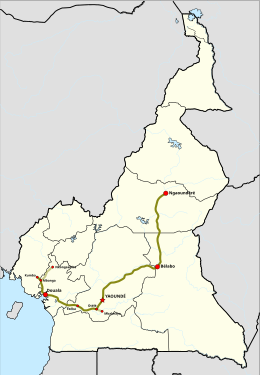Camrail: Difference between revisions
Rescuing 1 sources and tagging 0 as dead. #IABot (v2.0beta10) |
|||
| Line 24: | Line 24: | ||
'''Camrail''' is a company operating passenger and freight traffic between the two largest cities in [[Cameroon]] and several smaller cities. The company was formed in 1999 and granted a 20-year concession to operate the [[Cameroon National Railways Authority|Cameroon National Railway]]. The company is a [[subsidiary]] of French investment group [[Bolloré]] and the railway has been operated by [[Comazar]], a subsidiary of Bolloré, since 1999. According to the Comazar website, the government of Cameroon owns the [[Rail tracks|track]] while the [[rolling stock]] is owned by Camrail. |
'''Camrail''' is a company operating passenger and freight traffic between the two largest cities in [[Cameroon]] and several smaller cities. The company was formed in 1999 and granted a 20-year concession to operate the [[Cameroon National Railways Authority|Cameroon National Railway]]. The company is a [[subsidiary]] of French investment group [[Bolloré]] and the railway has been operated by [[Comazar]], a subsidiary of Bolloré, since 1999. According to the Comazar website, the government of Cameroon owns the [[Rail tracks|track]] while the [[rolling stock]] is owned by Camrail. |
||
According to a report by the [[World Bank]] in 2011, Camrail ranked relatively high amongst African countries for productivity indicators and was considered a regional leader in terms of implementing a concession to a non-state operator.<ref>{{cite web| title=AICD Cameroon Country Report| author=World Bank| date=2011| url=http://www.ppiaf.org/sites/ppiaf.org/files/publication/AICD-Cameroon-Country-Report.pdf| access-date=2014-05-01| archive-url=https://web.archive.org/web/20130319104855/http://www.ppiaf.org/sites/ppiaf.org/files/publication/AICD-Cameroon-Country-Report.pdf#| archive-date=2013-03-19| |
According to a report by the [[World Bank]] in 2011, Camrail ranked relatively high amongst African countries for productivity indicators and was considered a regional leader in terms of implementing a concession to a non-state operator.<ref>{{cite web| title=AICD Cameroon Country Report| author=World Bank| date=2011| url=http://www.ppiaf.org/sites/ppiaf.org/files/publication/AICD-Cameroon-Country-Report.pdf| access-date=2014-05-01| archive-url=https://web.archive.org/web/20130319104855/http://www.ppiaf.org/sites/ppiaf.org/files/publication/AICD-Cameroon-Country-Report.pdf#| archive-date=2013-03-19| url-status=dead}}</ref> The [[2016 Eséka train derailment]] took place on Camrail tracks and the company was under investigation by the government and was sued by relatives of the 79 passengers who died in the crash. |
||
==Services== |
==Services== |
||
Revision as of 11:08, 27 September 2019
 System map | |
 | |
| Übersicht | |
|---|---|
| Hauptsitz | Douala |
| Dates of operation | 1999–present |
| Successor | Régie nationale des chemins de fer du Cameroun |
| Technical | |
| Track gauge | 1,000 mm (3 ft 3+3⁄8 in) metre gauge |
| Length | 517 kilometres (321 mi) |
| Other | |
| Website | www |
Camrail is a company operating passenger and freight traffic between the two largest cities in Cameroon and several smaller cities. The company was formed in 1999 and granted a 20-year concession to operate the Cameroon National Railway. The company is a subsidiary of French investment group Bolloré and the railway has been operated by Comazar, a subsidiary of Bolloré, since 1999. According to the Comazar website, the government of Cameroon owns the track while the rolling stock is owned by Camrail.
According to a report by the World Bank in 2011, Camrail ranked relatively high amongst African countries for productivity indicators and was considered a regional leader in terms of implementing a concession to a non-state operator.[1] The 2016 Eséka train derailment took place on Camrail tracks and the company was under investigation by the government and was sued by relatives of the 79 passengers who died in the crash.
Services
As of May 2014, Camrail operated regular daily services on three routes:[2][3]
Gauge
1,104 km of 1,000 mm (3 ft 3+3⁄8 in) gauge track (1995 est.).
Rolling stock
- Locomotives: 50[citation needed]
- Railroad cars: 1299[citation needed]
Accidents
On 21 October 2016 at approximately 1100 local time, a passenger train derailed close to the town of Eséka. The train, traveling from the capital Yaoundé to the country's main port and economic hub, (Douala), was crammed with people because of road traffic disruption between the two cities and came off the tracks just before reaching Eséka. Initial reports are over 60 killed with many hundreds injured.[4] The cause of the accident is currently unknown.
References
- ^ World Bank (2011). "AICD Cameroon Country Report" (PDF). Archived from the original (PDF) on 2013-03-19. Retrieved 2014-05-01.
- ^ "Cameroon". seat61.
- ^ "Timetable". Camrail. 2014.
- ^ France-Presse, Agence (2016-10-22). "Sixty-three killed and 500 injured in train derailment in Cameroon". The Guardian. ISSN 0261-3077. Retrieved 2016-10-22.
External links
